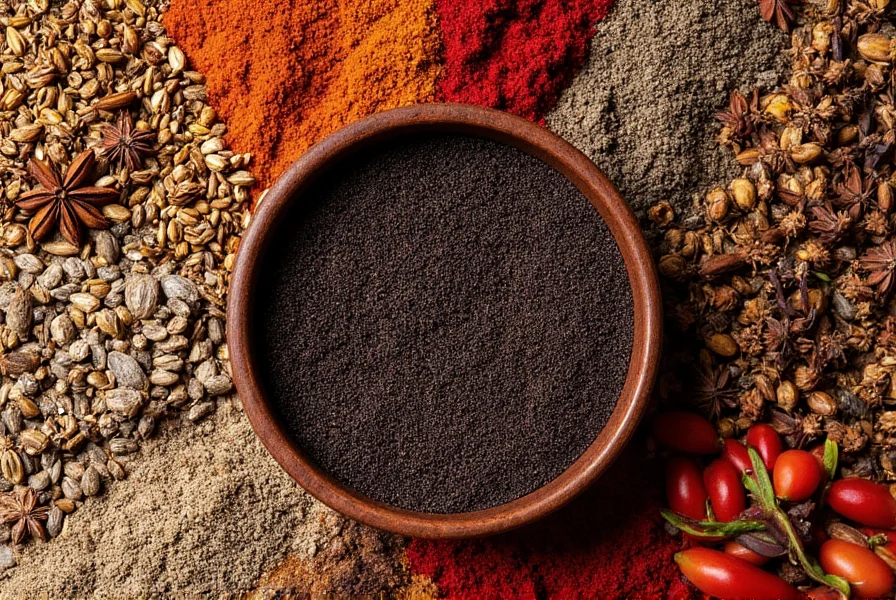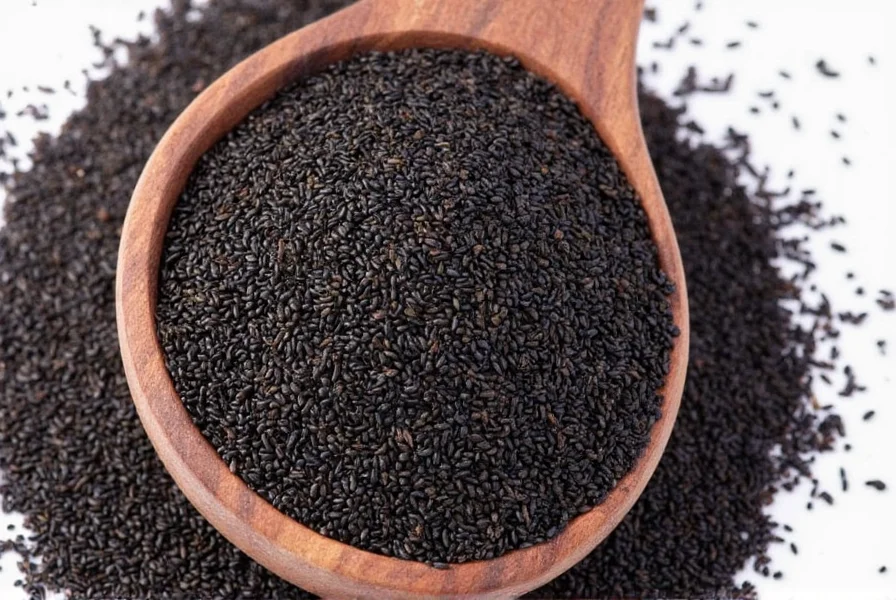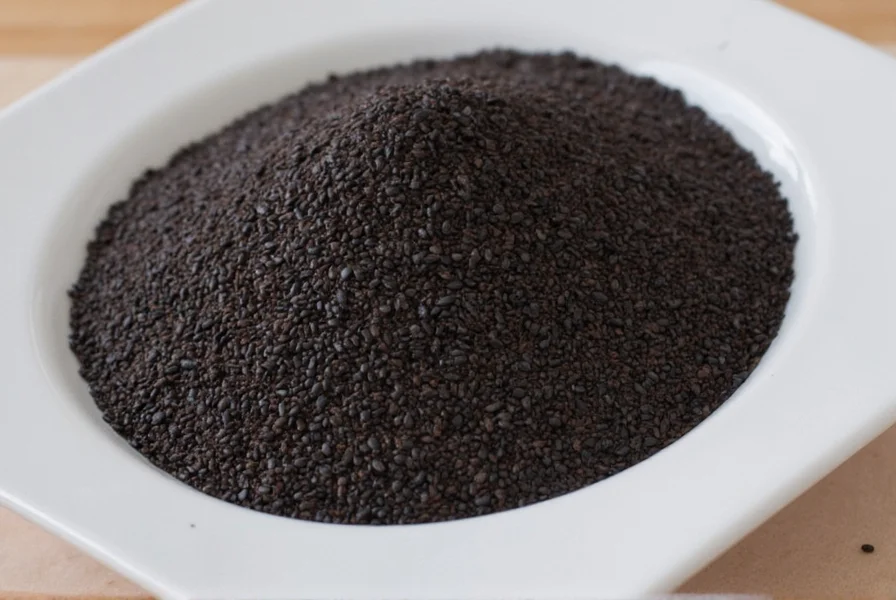When most people think of sesame seeds, they imagine pale beige or golden ones on burger buns. But black sesame? It's a distinct variety of Sesamum indicum with unique nutritional properties and culinary uses. Unlike white sesame, black sesame retains its outer hull, giving it a darker color, richer flavor, and higher antioxidant content. This guide provides evidence-based information on its benefits and applications.

Black sesame has a distinct nutty, earthy, and slightly sweet flavor with deeper roasted notes compared to white sesame. Its bold profile works well in both sweet and savory dishes, adding complexity without bitterness.
| Type of Sesame | Flavor | Common Uses | Color |
|---|---|---|---|
| Black Sesame | Nutty, earthy, rich | Paste, desserts, dressings | Jet Black |
| White Sesame | Mild, buttery | Toppings, light sauces | Beige |
Black sesame seeds are nutrient-dense, with scientifically verified benefits:
- Rich in Minerals: Per 100g, black sesame provides 975mg calcium (USDA National Nutrient Database), 14.6mg iron, and 351mg magnesium. A single tablespoon (9g) contains approximately 88mg calcium—less than a glass of milk (300mg), but significant for plant-based diets.
- Antioxidant Powerhouse: Contains sesamin, sesamolin, and anthocyanins that support heart and liver health. Studies show these compounds reduce oxidative stress (Journal of Agricultural and Food Chemistry, 2019).
- Dietary Fiber: 11g fiber per 100g aids digestion and satiety.
- Healthy Fats: High in omega-6 and oleic acid, which may lower inflammation.
Source: USDA FoodData Central, peer-reviewed nutritional studies
Black sesame is incredibly versatile. Here are evidence-based applications:
- Toast It: Dry-toast seeds in a skillet for 2-4 minutes until fragrant to enhance nuttiness. Ideal for rice bowls or noodle dishes.
- Make Paste: Blend toasted seeds with sesame oil and honey for a nutrient-rich spread. Use in hummus or as a dip base.
- Bake With It: Add crushed seeds to bread dough or cookie batter for texture and nutritional boost.
- Enhance Salads: Sprinkle whole seeds over grain bowls for crunch and visual appeal.

Look for these quality indicators:
Top 3 Recommended Brands
- Himalaya Organics Organic Black Sesame Seeds
Features: USDA Organic, non-GMO, sustainably sourced
Use Case: Raw consumption or baking
Occasion: Health-focused diets - Ace Seeds Premium Black Sesame
Features: Roasted & unroasted options, vacuum sealed
Use Case: Savory dishes or paste-making
Occasion: Weekly cooking routines - Savory Roots Black Sesame Blend
Features: Blends with flax and chia for extra nutrition
Use Case: Smoothies or yogurt toppings
Occasion: Quick breakfast boosters
Due to high oil content, store properly to prevent rancidity:
- Keep in an airtight container in a cool, dark place.
- For extended freshness, refrigerate after opening.
- Roast in small batches and cool completely before storage.

Try these nutritionally balanced recipes:
- Black Sesame Granola
Mix rolled oats, coconut oil, maple syrup, and 2 tbsp ground black sesame. Bake at 325°F for 20 minutes. - Spicy Sesame Noodles
Toss cooked noodles with peanut butter, soy sauce, chili oil, and top with toasted black sesame seeds for crunch. - Black Sesame Smoothie Bowl
Blend frozen bananas, almond milk, and 1 tbsp black sesame paste. Top with berries and chia seeds.
What is the difference between black sesame and white sesame seeds?
Black sesame retains its outer hull, giving it a darker color, stronger flavor, and higher antioxidant content. White sesame has the hull removed, resulting in milder taste and slightly lower nutrient density. Both are nutritionally valuable, but black sesame offers more calcium and iron per serving (USDA data).
Is black sesame healthier than white sesame?
Black sesame generally has higher levels of calcium, iron, and antioxidants due to its intact hull. However, both varieties provide similar benefits. For optimal nutrition, incorporate both into your diet. Always consult a healthcare provider for personalized dietary advice.
How do I toast black sesame seeds properly?
Use a dry skillet over medium-low heat. Add seeds in a single layer and stir constantly for 2-4 minutes until fragrant and slightly darker. Avoid burning by removing from heat immediately when they begin to pop. Let cool completely before use or storage.
Can I eat black sesame seeds raw?
Yes, raw black sesame is safe to eat, but toasting enhances flavor and bioavailability of nutrients. Raw seeds contain phytic acid, which may slightly reduce mineral absorption. Toasting breaks down phytic acid, making calcium and iron more accessible to your body.
Does black sesame really help with hair growth?
Black sesame contains copper and magnesium that support overall hair health, but there is no conclusive scientific evidence linking it directly to hair growth. Hair growth is influenced by multiple factors including genetics and overall nutrition. For hair concerns, consult a dermatologist or healthcare professional.
How much black sesame should I eat per day?
A standard serving is 1-2 tablespoons (10-20g) daily. This provides significant nutrients without excessive calories (50-100 kcal). Due to high fat content, consume in moderation. Individuals with nut allergies should consult a doctor before use.
Black sesame is a versatile, nutrient-dense ingredient backed by scientific research. Its rich flavor and health benefits make it a valuable addition to balanced diets. Always prioritize verified information from reputable sources like the USDA or peer-reviewed studies when incorporating new foods into your routine.










 浙公网安备
33010002000092号
浙公网安备
33010002000092号 浙B2-20120091-4
浙B2-20120091-4